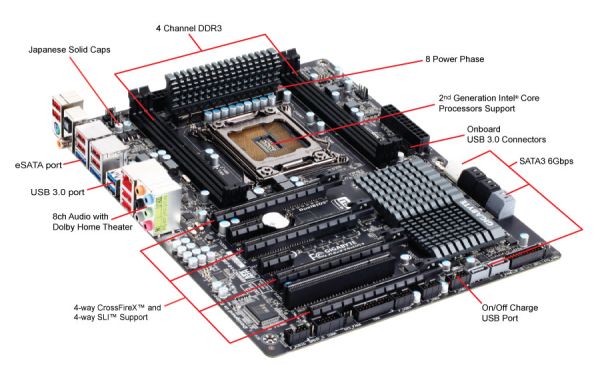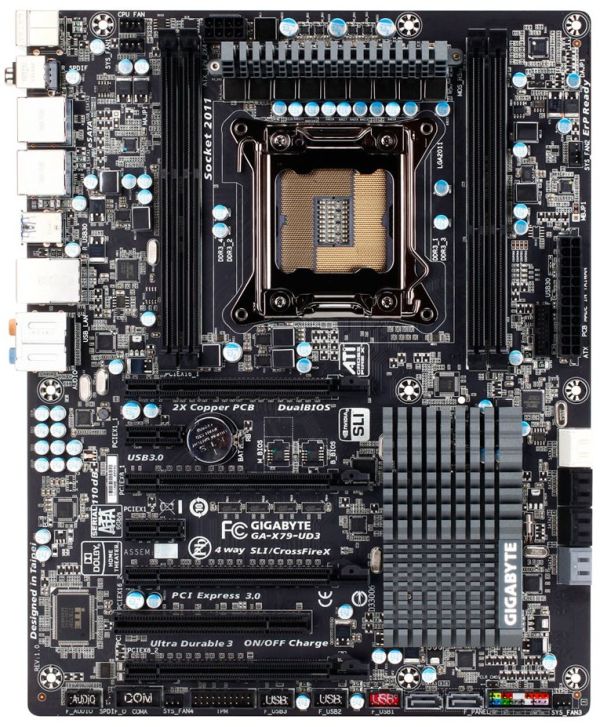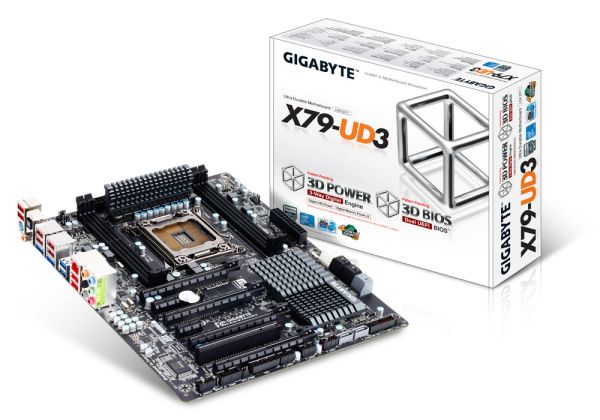Gigabyte GA-X79-UD3 Review
by Ian Cutress on December 26, 2011 4:37 PM EST- Posted in
- Motherboards
- Gigabyte
- X79
- Sandy Bridge E
Over the years, Gigabyte has given us some interesting products. More recently in the past 18 months, Rajinder gave their H55N-USB3 motherboard a well deserved recommendation, and more recently, I have scrutinized their Sandy Bridge range. For X79, Gigabyte is uncharacteristically launching only a few motherboards, of which we are looking at their cheapest model, the X79-UD3. We are also for the first time introduced to what Gigabyte believe should be a graphical BIOS compared to their competitors. Read on for the full review.
The full Gigabyte X79 range consists of a UD3, a UD5, an overclock oriented UD7-OC and a gamer G1 Assassin 2. Typically we see Gigabyte jump at the more esoteric features of a chipset, always willing to take advantage of newer features, but sometimes at the expense of the in-the-box package or memory compatibility.
Overview
It is hard to have a unique overview on the UD3, especially if we compare it to other boards on the market. The price ($270 MSRP) suggests it should sit square between the ASUS P9X79 Pro ($330) and the ASRock X79 Extreme4 ($235), both of which we have reviewed recently, so the expectation should be that it falls between the two:
| ASUS P9X79 Pro |
Gigabyte GA-X79-UD3 |
ASRock X79 Extreme4 |
|
| Price (MRSP) | $330 | $270 | $235 |
| Memory Slots | 8 | 4 | 4 |
| PCIe |
2 x PCIe x16 2 x PCIe x8 2 x PCIe x1 |
2 x PCIe x16 2 x PCIe x8 2 x PCIe x1 1 x PCI |
2 x PCIe x16 1 x PCIe x8 2 x PCIe x1 2 x PCI |
|
SATA 6 Gbps SATA 3 Gbps |
4 4 |
6 4 |
5 4 |
|
USB 3.0 USB 2.0 |
6 14 |
4 14 |
4 12 |
| Power/Reset Buttons | Yes | No | Yes |
| Fan Headers | 6 | 5 | 6 |
| VRM | 8+2 | 8+1 | 6+2 |
| Clear CMOS | Button | Header | Button |
| LAN | Intel 82579V | Intel 82579V | Broadcom BCM57781 |
| Audio | Realtek ALC898 | Realtek ALC898 | Realtek ALC898 |
| In The Box |
IO Shield Manual Driver CD 6 x SATA cables Long SLI Cable 3-way Bridge |
IO Shield Manual Driver CD 4 x SATA Cables Long SLI Cable Long CFX Cable 3-way SLI Bridge 4-way SLI Bridge |
IO Shield Driver CD 4 x SATA Cables Long SLI Cable 3-way SLI Bridge |
| Warranty | 3 Years | 3 Years | Depends on Region |
Overall, we could consider this review in two ways. One, in terms of performance and features, which for a $270 fits reasonably well in the X79 schema, but comes up against stiff competition from ASRock offerings we have reviewed. Or two, in terms of my experience with the board, which wasn't the most positive experience. I initially had memory problems which required another memory kit, which worked fine the first time to get results, then not any other subsequent time, suggesting a BIOS update will be needed for memory compatibility. I also had an issue with the PCIe bandwidth, which didn't impact to any noticeable degree with results (it only affected certain dual GPU tests) which Gigabyte assure me was more a hardware anomaly rather than par-for-the course.
I see a lot of system bundles here in the UK that offer Gigabyte boards, and no doubt this is a board that should sell well for people looking to move to X79/Sandy Bridge-E on not a lot of money. It has a couple of unique features that other vendors have the option to use but do not (TPM being the prime example), as well as a substantial number of SATA 6 Gbps ports to use, as long as you're not in quad-GPU land.
Visual Inspection
This first image of the board is one I pulled directly from the Gigabyte website - a schematic of the X79-UD3 indicating various features. The CPU socket area is surrounded on either side by two DIMM slots, for quad-channel memory support. The UD3 has one DIMM per channel, which in the 'budget' land of X79 is standard. The 8+1 CPU VRM is below a grey spiky heatsink that doesn't seem to heat up significantly under CPU load, suggesting it is efficient at heat dissipation. Three of the motherboard fan headers are in this area - there are CPU and a SYS fan headers on the top left (both 4-pin), and another SYS fan header to the right of the memory, also 4-pin. The other two SYS headers are on the bottom of the board, and are both 3-pin.
The SATA ports are numerous but slightly abnormal. The pair of white ports don't fit in to the color scheme of the board, but are the two SATA 6 Gbps ports from the PCH. Underneath, are the four black ports, which are the four SATA 3 Gbps, also from the PCH. The two grey ports underneath are a pair of SATA 6 Gbps from a Marvell 88SE9172 controller - there are two more grey SATA 6 Gbps ports from another Marvell controller, but these are located on the south end of the board, with the other headers. Gigabyte have at least done a bit of thinking here - even though these two ports stick out of the board and are at the bottom, the only way to block them is when a user is in quad-GPU mode with four dual slot discrete GPUs. These two ports are ideal to fit in some more drives at the bottom of a case, for example when the SSD is bolted to the bottom rather than the mechanical HDDs which could be to the side.
The PCH/chipset cooler is low profile and multi-ridged so allow for maximum airflow. Normally on some of the higher end boards, we see this heatsink attached to another heatsink via a heatpipe. Gigabyte's large but low profile negates the need for this, however it does get a tad warm to touch during high throughput scenarios.
So far we have seen most X79 motherboards having power/reset/Clear CMOS buttons on board and a Debug LED - useful for reviewers when coming up against hardware limits but also for consumers if a certain error has arisen. Unfortunately we don't see these on the UD3, perhaps for different goals (compared to the ASRock X79 Extreme4, which does have them and is cheaper), which is unfortunate. Users will have to short two pins to get a Clear CMOS, which given the initial graphical BIOS implementation and overclock issues I had, is also a little frustrating.
The PCIe layout is as simple as can be, with (from the top) an x16, x1, x8, x1, x16, x1, x8 - when the bottom x8 is populated, the second x16 reduces to x8, as these slots are multiplexed. All the x16 are PCIe 3.0 to help with PCIe bandwidth limited scenarios, but again I have to credit Gigabyte for their thought in layout - I always envisage the scenario when I have two full length, double slot GPUs, and an x1 card. In the X79-UD3, I'd populate the two x16 slots with GPUs, and the x1 card in the available x1 slot (the second x1 on board). This gives both GPUs at least one slot width for airflow. Some motherboard manufacturers still can't get this right, so kudos to Gigabyte.
The back panel as awash with USB ports - eight USB 2.0 ports in red and two USB 3.0 ports in blue. There are also two blue eSATA 6 Gbps ports, a solitary PS/2 port, optical and coaxial SPDIF outputs, an Intel gigabit Ethernet connector, and audio jacks from a Realtek ALC898. Overall, this is a little simple - no Clear CMOS button, and no Firewire ports.














39 Comments
View All Comments
ComputerGuy2006 - Monday, December 26, 2011 - link
Why do most motherboards on this "high end chipset" that cost 200-500$ tend to only have a single NIC... Its pathetic.The overall LGA 2011 boards are so lame for their price I did not even bother buying a new PC. I now plan on just buying a low end chipset/cpu (ivy bridge) and just paying for an extra NIC...
Metaluna - Monday, December 26, 2011 - link
At least it's not Realtek. I'll take one Intel NIC over two Realtek's any day.Tchamber - Monday, December 26, 2011 - link
I have a desktop, 2 laptops networked with my brother's desktop, and i don't use the two ethernet ports on my desktop, wifi for network and gigabit ethernet for file transfers to/from laptops. What else is it for?Iketh - Tuesday, December 27, 2011 - link
what?cactusdog - Tuesday, December 27, 2011 - link
Haha This board has been recalled why is it even here?? It has a problem with Mosfets exploding.shatteredx - Monday, December 26, 2011 - link
I would assume that purchasers of high-end motherboards already have a router with gigabit ports, so what's the point of having 2 NICs?Another thing: people rave about the quality of Intel NICs over brands like Realtek, but I've owned both and they both performed identically (from what I observed). In fact, I would say that the Realtek NIC has a big advantage over the Intel NIC: Windows 7 can install the Realtek NIC with no driver CD but has no built-in drivers for the Intel one. This could potentially be very inconvenient the next time I reinstall Windows and can't find my mobo CD.
Metaluna - Monday, December 26, 2011 - link
Realtek's drivers seem to have improved recently (especially in the Win7 era), but they have developed a reputation over the years for unreliability and inconsistent performance, especially under heavy loads. I found this out the hard way a few years ago when I installed a new home file server capable of saturating a gigabit link. Suddenly, several of the PCs on my home network (including the file server itself) started dropping off the network erratically, especially during large file copies. After at least a month tearing my hair out, I finally took a shot in the dark and put an Intel NIC in the server, and the problem vanished. The server's network port never went down again, but a couple of the clients were still having problems. I replaced those NICs as well, and suddenly I had a network again. The common thread? All the failing machines had Realtek 8111C/D chips. Remarkably the failures were consistent across different revisions of the Windows driver, and even different OS'es (Server 2003/WHS, XP, Win7)I think the reason people go with Intel is because they're about the only other option available on the market anymore. You used to see motherboards with Marvell, Broadcom, or Atheros NICs, but Realtek pretty much killed them off, and even most of the add-in PCIe cards have gone Realtek, so Intel is really the only alternative if you want to try something different. But it's pretty telling that server motherboards from the likes of Intel, Supermicro, and even Asus never use Realtek (except possibly for the IPMI port). So I'm glad to see Intel trickling back into some of the high end consumer boards.
Ryan Smith - Tuesday, December 27, 2011 - link
You still see Marvell in mobos now and then. The EVGA X79 SLI we use on the GPU testbed has a Marvell 88E8059.Stuka87 - Tuesday, December 27, 2011 - link
I have done some pretty extensive performance test with various NIC's out there. For basic day to day use, there is no difference. But when you start cranking up the frames per second (total throughput means nothing really, has a lot more to do with frames per second), many of the "other" brands (Broadcom and Realtec for instance) cannot stand side bys ide with most Intel NIC's. Although there are some Intel's that are not very good either.However, the point of two NIC' has nothing to do with speed typically. Yes you can bond them together, which is awesome if you are running a lot of VM's off a NAS. But its also very handy if you are on two separate networks.
Oh, and Windows 7 does have built in drivers for Intel NIC's. Where id you see otherwise? Granted they are older ones, just as the other NIC drivers are. But they function fine until you can get the latest.
Metaluna - Wednesday, December 28, 2011 - link
Sandy Bridge boards mostly are using the new Intel 82579V chip, which from what I've read is different enough that the generic Intel e1000 drivers won't always work with it. This has been an issue with some OSes like FreeBSD 8 and VMware ESXi 5 (not sure about Linux distros).My Asus P8Z68-V uses this chip, but unfortunately I can't remember if Win7 supported it out of the box or not.